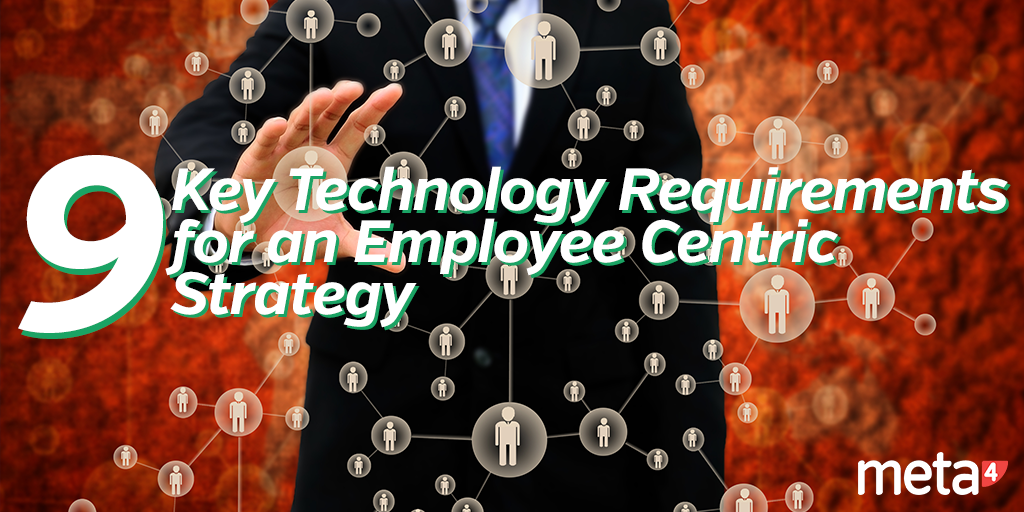We discussed the relevance of the technology for an employee-centric strategy in the previous post, “Technology Requirements for an Employee-Centric Strategy”. Next, we will delve into the key features that an HR technology solution must have, aligning them with the most important points and phases in the implementation and deployment of an employee-centric strategy.
1. Know and understand our starting point
First of all, it is important to conduct an analysis of our organization through using sociodemographic variables for the human workforce (age, education, experience in the company as well as prior experience, department they belong to, level in the organization structure, etc.) as well as other behavioural variables and indicators (performance scores, gaps detected, goal achievement levels, voiced needs and concerns, engagement levels / employee net promoter score, …). It follows that for the solution to be data-driven and accurate it must allow HR to store, extract, integrate, consolidate and operationalize all this information kept up to date. This will become the guiding principle of HR activities and the actions to be designed and implemented afterwards.
2. Segment the workforce
This is not merely about defining clusters of employees, but also undertaking a more broadly scoped valuation across segments under analysis. This involves extrapolating values on how things stand as well as on the realistic possibilities for actions on these groups and their needs. Hence, the solution must allow us to identify the best-fit and the most valuable employee segments for achieving the company’s objectives, while identifying which ones require prioritized actions. Ultimately, the aim is to optimize the organization’s power and tailor the value proposition (on how a given HR package solves problems, improves a situation, delivers certain benefits, or brings advantages over competitors) that we next determine for the company-wide level and for each specific employee segment identified.
3. Determine the value proposition
Even though no tool can do this, the fact is an HR solution must nevertheless give us the information needed to define a relevant value proposition for employees. We need key differentiators to outdo what the competitors fighting for the same talent can offer; we need accurate information that we can use to motivate and engage the employee. Failures in this respect weaken HR actions and project a poorer image than we want. It is not so much about defining the product that HR will deliver, but more about formulating the guidelines which are always driven by the information we have. Hence, we must have the required capabilities to execute the value proposition. This means our solution must help with the definition as well as assure execution. We should consider involving employees here and in the next point. Focus groups, targeted surveys, or any other form of assessment of the value proposition or even its definition will help us greatly to find out what employees think, and our solution should support us in this.
4. Define the employee mix
This is the specific product with a package of defined HR actions that we are going to roll out to each of the established employee segments and which must be:
- Consistent with the value proposition: as pointed out earlier, this will be a strategy plan rather than a solution, since a tool cannot think for us.
- Holistic: this means covering all the different areas HR manages to leave no stone unturned. Perhaps in some areas there is nothing to address, nevertheless we must still analyse them to be absolutely sure. Here, a solution that manages all people processes enables us to gain a comprehensive and integrated view of actions and activities, to combine and interrelate them with the purpose of effectively addressing the needs of each employee segment, and thus, the company’s needs.
- Measurable and quantifiable: the solution must allow us to specifically measure surveys and results, identify the consequences and the impact of measures taken, as well as estimate the corresponding costs and implications through process modification, resources allocation, among others.
5. Ability to adapt to new external challenges
While employees suffer and feel, there are situations or circumstances in which the employee is neither an actor nor a direct recipient. These include the latest trends for new organizational structures (e.g. the concept of liquid structures, ecosystems, etc.) or new forms of work (e.g. gig economy platforms, uberization). We need to account for these in our employee mix for the entire company or for a given employee segment. That’s why the technology solution we use must contemplate and accommodate the constant changes occurring in organizations.
6. Manage implementation
Evidently, it is essential to establish what, how and when we are going to implement our measures. Moreover, from the perspective of a tool, this means that there are two fundamental pre-requisites. Firstly, there must be a pre-existing deployment of the proposition: training programmes, benefit programmes, development programmes, salary increases, and more. Aspects that make up the compensation package must be accessible to the employee—who must be able to see and manage it, where necessary. Secondly, this must be accessible and well communicated, as things that are already there and available aren’t enough, the employee must be able to obtain information and / or access it in a natural way. Each employee must know what is available to them so that that they can assess and use it. This, in turn, has other implications for a tool since HR must act proactively and responsively:
- Proactivity: portals and employee self-services allow us to disseminate our approach and associated initiatives designed. Although not everyone has access, unless we want to see ourselves immersed in a constant chain of emails, which may be necessary at one point or another, it is better for employees have a tool that lets them obtain updated information on where their products are, whether they are already available, changed, or can be requested, and more.
- Responsiveness: a solution must support simplicity in the way employee questions and / or considerations are managed. This will bring the benefit of credibility and a sense of closeness in the eyes of employees. The solution should also allow us to propose actions that respond to these questions / needs. Although emails may be a solution, tools more akin to the digital interactions, e.g. online dialogues, that we have in our personal lives with companies we are customers of are more appropriate. They will convey a better image and will allow us to deliver immediacy in responses—even if it is only to respond digitally with, “Let me review it and I will answer as soon as possible.”
7. Contribute to improve the employee experience
Obviously, it is of little use to do things if they do not generate a positive employee experience. Although there are many aspects of the employee experience that are beyond the scope of a tool, it is no less true that this should be a help and not a hindrance. This means that employee interactions with the tool must generate positive experiences—simplicity, user friendly, multi-device, and more. Similarly, HR must be able to work on each of the touchpoints for the employee experience using the tool. HR must design positive experiences throughout the employee journey so that he or she feels at the centre and be the focus of management. In this sense, we need a tool that manages HR processes in a comprehensive and integrated manner, facilitating the creation of workflows focused on the touchpoints mentioned earlier for each employee segment. This tool becomes a facilitator providing high quality assistance in the operationalization of our strategy. Plus, if it contemplates or supports interactions with the employee’s personal side of life, it will contribute to improving the critical employee experience.
8. Analyse, measure and readjust
We are living in an era marked by digitization, business intelligence, big data and more. All these novel concepts assist us in the definition of our initiatives. However, we must remember that the right employee-centric strategy requires constant, or at least frequent, dialogue with the employee. By dialogue we mean not just what they communicate to us directly, but also how they act, and the results obtained. Similarly, at the end of a training programme, we measure not just the opinions and suggestions about the course, but also what the employees are applying, and the success they achieve with it. Here we must also measure goal achievements at the employee and at the organizational level to find out what we are getting out of the strategy and the initiatives we launched. And if certain components of our employee mix do not work (either they are not valued, or we do not gain added value from their implementation), then we must rethink their real value in our employee-centric strategy. Therefore, the more information we can collect on not only the results but also the reasons for them, the improvements proposed by employees and how these are related to the variables under consideration, the more effective we will be for the next time around. In short, this is not about measuring what interests us, but about measuring what interests them.
9. Capacity to evolve
Nowadays we must think of our employees as customers, both ours and others. Just as we analyse our competitors through HR benchmarking practices and update accordingly, when we examine the positive experiences employees have in their external daily lives, we must plan to incorporate any relevant experience with its key touchpoints and interactions into our solution. It is not so much about “amazonizing” HR, but rather understanding what makes employees special, why, and how we can replicate this and improve it in our model. This implies that our technology solution must be updating and integrating these external features constantly and in a familiar way imitating existing experiences. If the world together with customer demands and interests evolve, so too must a technology solution.






